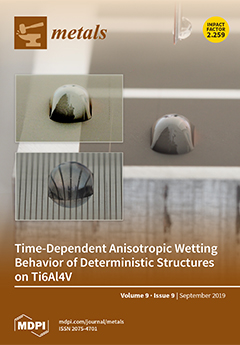In this work, the DD98M single crystal superalloys were brazed to themselves using a Pd-Si composite filler. The effect of brazing temperature and soaking time on the microstructure and mechanical behavior of the joints was studied. The microstructure and phase constitution in the
[...] Read more.
In this work, the DD98M single crystal superalloys were brazed to themselves using a Pd-Si composite filler. The effect of brazing temperature and soaking time on the microstructure and mechanical behavior of the joints was studied. The microstructure and phase constitution in the joint were identified by the SEM and EDS analysis. The results indicated that the joint obtained was constituted by DD98M/zone 2/zone 1/zone 2/DD98M. The zone 1 was primarily made up of the Ni (Pd, Cr, Co) (s.s), Pd
4Si, Pd (Ni, Ti, Al) (s.s) and Pd-rich Ni (Pd, Cr, Co) (s.s), while the zone 2 consisted of the Ni (Pd, Cr, Co) (s.s) and Al
2Pd
5. During the brazing process, increasing the brazing temperature strengthened the fluidity of the liquid filler, which was favorable to eliminating the solidified pores in the brazing seam. Furthermore, a higher brazing temperature would cause the phases in the zones 1 and 2 to be coarsened remarkably. When setting the brazing temperature to 1060 °C, extending the soaking time made the amount of Pd (Ni, Ti, Al) (s.s) decrease, whereas the amount of Pd
4Si increased, because the peritectic reaction between the Pd (Ni, Ti, Al) (s.s) and remnant liquid filler was enhanced. Among the brazing process parameters under investigation, the maximum joint average shear strength obtained reached 338 MPa when the joint was brazed at 1060 °C for 30 min. A ductile fracture mode happened during the shear tests under a joining condition. The work performed can provide valuable data to design the single crystal superalloy brazed joint.
Full article





